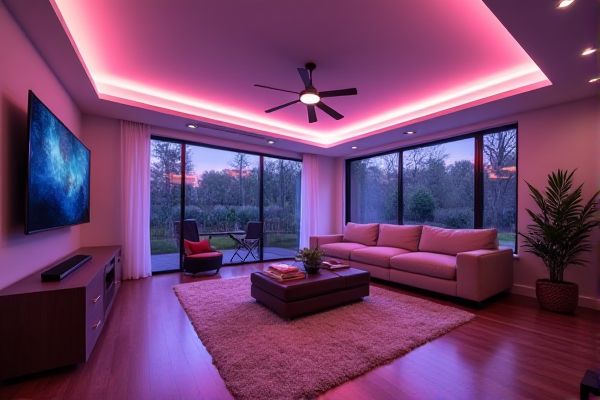
LED strip lighting offers flexible, continuous illumination ideal for highlighting long surfaces or creating ambiance, while puck lighting provides focused, spot-like brightness perfect for task lighting or accenting specific areas. Explore the rest of the article to determine which lighting solution best suits your needs and enhances your space.
Table of Comparison
| Feature | LED Strip Lighting | Puck Lighting |
|---|---|---|
| Design | Flexible, linear strips | Compact, round units |
| Installation | Adhesive backing, easy to cut | Mounted screws or adhesive pads |
| Application | Under cabinets, cove lighting, accent lines | Task lighting, cabinets, display cases |
| Light Output | Continuous, uniform glow | Focused, spotlight effect |
| Power Consumption | Low wattage, energy efficient | Moderate wattage, focused beam |
| Customization | Color-changing options, dimmable | Limited color options, generally dimmable |
| Cost | Generally lower per foot | Higher per unit |
| Lifespan | 25,000 to 50,000 hours | 25,000 to 40,000 hours |
Understanding LED Strip Lighting
LED strip lighting consists of flexible circuit boards embedded with surface-mounted light-emitting diodes, offering customizable lengths and color options for versatile applications. Unlike puck lighting, which provides concentrated, fixed points of light, LED strips deliver continuous and even illumination ideal for accentuating architectural features or under-cabinet lighting. You can easily control brightness and color temperature with compatible dimmers or smart systems, enhancing your space's ambiance and energy efficiency.
What Are Puck Lights?
Puck lights are small, circular LED fixtures designed for accent or task lighting in cabinets, under shelves, or in tight spaces where discreet illumination is needed. Unlike LED strip lighting, which offers continuous, flexible light along lengths, puck lights provide focused, high-intensity spots ideal for highlighting specific areas or objects. Their compact size and efficient LED technology make puck lights a popular choice for enhancing ambiance or improving visibility in detailed applications.
Design and Aesthetic Differences
LED strip lighting offers a sleek, continuous line of light ideal for creating modern, minimalist designs and accentuating architectural features with seamless illumination. Puck lighting provides focused, circular pools of light that are perfect for highlighting specific areas or objects, adding depth and contrast to your space. Your choice between the two depends on whether you prefer subtle, ambient lighting or targeted, statement illumination to enhance your interior design.
Installation Processes Compared
LED strip lighting offers flexible installation, easily adhering to surfaces with peel-and-stick backing, making it ideal for continuous, linear lighting projects. Puck lighting requires drilling and mounting individual fixtures, which may involve more precise placement and wiring but provides focused, localized illumination. Your choice depends on whether you prefer quick, versatile setup or targeted, accent lighting with a more labor-intensive installation.
Brightness and Light Distribution
LED strip lighting offers consistent brightness and evenly distributed illumination along its entire length, making it ideal for under-cabinet lighting and accenting large surfaces. Puck lighting provides focused, intense brightness in small, concentrated areas, creating spotlights or highlighting specific objects with a narrower beam angle. Comparing light distribution, LED strips deliver diffuse, uniform light coverage, while puck lights produce sharp, directional beams that emphasize localized brightness.
Energy Efficiency: LED Strip vs Puck
LED strip lighting offers superior energy efficiency compared to puck lighting, consuming less power per foot while providing continuous illumination. Your choice impacts electricity usage, as LED strips use low-wattage diodes that distribute light evenly, minimizing waste. Puck lights, while effective for focused areas, generally draw more energy for similar brightness levels, making strips more cost-effective for extended applications.
Best Use Cases for Each Lighting Type
LED strip lighting excels in creating continuous, flexible illumination for under-cabinet areas, accentuating architectural features, or providing ambient lighting in long, narrow spaces. Puck lighting is ideal for focused task lighting, such as highlighting countertops, display cases, or specific work areas where concentrated, directional light is required. Both lighting types enhance interior design, but LED strips offer seamless coverage while puck lights deliver localized brightness.
Cost Comparison: Upfront and Ongoing
LED strip lighting generally offers a lower upfront cost compared to puck lighting, making it a budget-friendly option for large areas or accent lighting. Maintenance costs for LED strips tend to be minimal due to their longer lifespan and energy efficiency, reducing ongoing expenses. Your choice should consider the installation complexity, as puck lighting may require additional hardware and labor, increasing initial costs despite comparable energy consumption.
Durability and Maintenance
LED strip lighting offers greater durability due to its flexible, adhesive-backed design and resistance to moisture and dust, making it ideal for various environments. Puck lighting, while robust with its compact and sturdy housing, may require more frequent maintenance for bulb replacements or battery changes, especially in high-use areas. Both lighting types benefit from energy-efficient LED technology, but strip lights generally demand less upkeep and have a longer lifespan.
Choosing the Right Lighting for Your Space
LED strip lighting offers flexible, continuous illumination ideal for accentuating architectural features, under-cabinet areas, or creating ambient mood lighting, while puck lighting delivers focused, directional light perfect for highlighting specific objects or workspaces. Your choice depends on the room's purpose and desired aesthetic; LED strips provide even light coverage, whereas puck lights add depth with concentrated beams. Considering factors like installation complexity, energy efficiency, and control options will help you select the perfect solution for your lighting needs.
 homyna.com
homyna.com